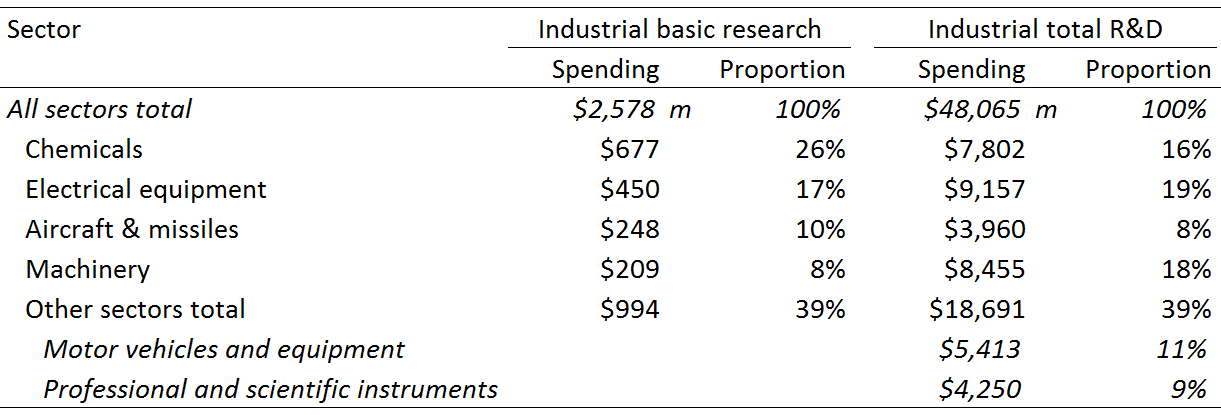Industrial basic research and industrial total R&D was performed in a few sectors by a few companies in the US in 1984
 [1, 2]
[1, 2]
Industrial basic research plugs industry networks into universities
Most basic research in the United States is conducted within the university community, but in order to “plug in” to these research centers and to exploit the knowledge that is generated there, a firm must have some in-house capability. The most effective way to remain effectively plugged in to the scientific network is to be a participant in the research process.
When basic research in industry is isolated from the rest of the firm, whether organizationally or geographically, it is likely to become sterile and unproductive.
The history of basic research in industry suggests that it is likely to be most effective when it is highly interactive with the work, or the concerns, of applied scientists and engineers. This is because the high technology industries are continually throwing up problems, difficulties and anomalous observations that are most unlikely to occur outside of a high technology context.
High technology industries provide a unique vantage point for the conduct of basic research, but in order for scientists to exploit the potential of the industrial environment it is necessary to create opportunities and incentives for interaction with other components of the industrial world. …the performance of basic research may be thought of as a ticket of admission to an information network.
Industrial basic research often is the unplanned byproduct of paying talented people to work on great practical problems
…the history of basic research in… industry suggests that a very large part of this research has been unintentional.
…if… Sadi Carnot… had been asked… what he thought he was doing, his answer would have been that he was trying to improve the efficiency of steam engines. As a byproduct of that particular practical interest, he created the modern science of thermodynamics.
If Pasteur had been asked what he thought he was doing back around 1870, he would have replied that he was trying to solve some very practical problems connected with fermentation and putrefaction in the French wine industry. He solved those practical problems – but along the way he invented the modern science of bacteriology.
Industrial basic research at Bell Labs, for example, started with practical problems and ended up producing scientific advances
Back at the end of the 1920s when transatlantic radiotelephone service was first established, the service was poor because there was lots of static. Bell Labs asked a young man, Karl Jansky, to determine the source of the noise so that it could be reduced or eliminated. He was given a rotatable antenna to work with. Jansky published a paper in 1932 in which he reported three sources of noise: Local thunderstorms, more distant thunderstorms, and a third source. which he identified as “a steady hiss static, the origin of which is not known”. It was this “star noise”, as he labelled it, which marked the birth of radio astronomy…
…Bell Labs decided to support basic research in astrophysics because of its relationship to the whole field of problems and possibilities in microwave transmission, and especially the use of communication satellites for such purposes. It turned out that, at very high frequencies, rain and other atmospheric conditions became major sources of interference in transmission. This source of signal loss was a continuing concern in the development of satellite communications. It was out of such practical concerns that Bell Labs decided to employ Arno Penzias and Robert Wilson. Penzias and Wilson… first observed the cosmic background radiation, which is now taken as confirmation of the “big bang” theory of the formation of the universe, while they were attempting to identify and measure the various sources of noise in their antenna and in the atmosphere. Although Penzias and Wilson did not know it at the time, the character of the background radiation that they discovered was just what had been postulated earlier by cosmologists favoring the “big bang” theory. Penzias and Wilson appropriately shared a Nobel Prize for this finding.
Industrial basic research at Bell Labs also started with practical problems and ended up producing practical advances
…basic research can provide valuable guidance to the directions in which there is a high probability of payoffs to more applied research. In this sense, William Shockley’s education in solid state physics during the 1930s may have been critical to the decision at Bell Labs to look for a substitute for the vacuum tube in the realm of semiconductor materials – a search that led directly to the invention of the transistor.[2]
- National Science Foundation. National Patterns of Science and Technology Resources 1986. NSF 86-309. 1986, pp. 59, 56.
- Rosenberg, Nathan. “Why Do Firms Do Basic Research (with Their Own Money)?” Research Policy 19.2: 165-174.